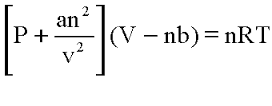A quick revision tool for the grip on the chapter
1
Ideal gas equation
Ideal Gas Equation states the four gas variables and one constant for a better understanding. The four gas variables are: pressure (P), volume (V), number of mole of gas (n), and temperature (T). Lastly, the constant in the equation shown below is R, known as the the gas constant.
2
Real gases by Van der waals equation

The above formula is used to find the behavior of real gases by the Van der Waals equation.
3
Difference between ideal and real gas

content Text
4
Graham's law of diffusion

Graham's law states that the rate of effusion or diffusion of a gas is inversely proportional to the square root of its molecular weight.
5
Liquefaction of gases
Liquefaction of gases is the process by which a gas is converted to a liquid. For example, oxygen normally occurs as a gas. However, by applying sufficient amounts of pressure and by reducing the temperature by a sufficient amount, oxygen can be converted to a liquid. Liquefaction of gas occurs when its molecules are pushed closer together.
6
Compressibility factor and its significance

Compressibility factor is calculated by above formula. For ideal gas z=1 and hence , PV=nRT over a range of temperature and pressures. The deviation of gas from ideal behaviour is calulated by finding the value of deviation of Z from value 1.
Compressibility factor is the ratio of the actual molar volume of the gas to the calculated molar volume at the same temperature and pressure.
Compressibility factor is the ratio of the actual molar volume of the gas to the calculated molar volume at the same temperature and pressure.


